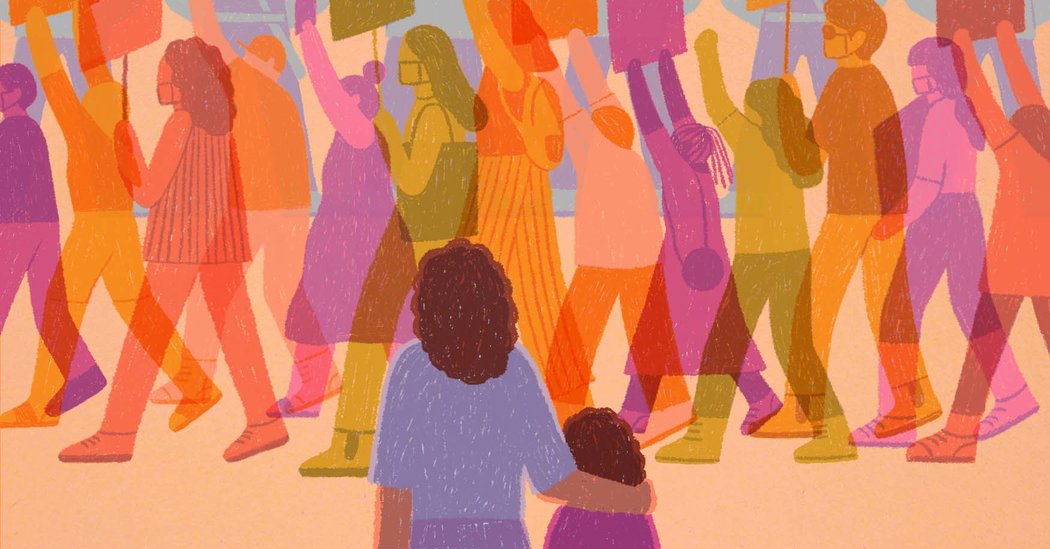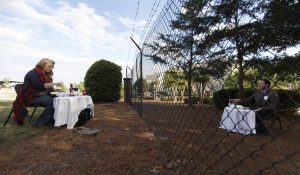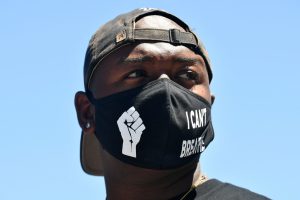Last Tuesday evening I took my 6-year-old son, Javier, around our neighborhood in Jersey City and introduced him to all the “mom” cops.
Two peaceful marches had dispersed hours before, but at dusk, police still stood on every corner. There has been no curfew here, and marches have been large and nonviolent. Still, businesses had boarded up or lowered their steel grills; the air roiled with tension. I hailed the manager of our local Key Food, which usually had a line around the block. He was putting their grill down, and told me, “Just in case.”
But the three officers on our corner looked nothing like the threatening phalanxes of what appeared to be mostly white men in military gear filling the media. First of all, there was not a riot shield in sight. Second, they were wearing regular Jersey City Police Department uniforms. And two of them were women — and they were not white.
I hadn’t planned to, but I introduced my son immediately.
“Javi, see, there are mommy cops too,” I said.
“That’s right — I have three kids!” said one officer immediately.
“I have two, honey,” said the other. “You want to take a picture?”
Javi’s face cracked into a smile, and they all shook his hand. I wasn’t only reassuring my son, I realized, I was reassuring myself.
I chose to raise my son in Jersey City because it’s multi-ethnic and tight-knit, the kind of place where you call out to your grocery store manager from across the street. It’s a place where advocates have pledged to hold weekly protests against police brutality at City Hall, calling for cutting the police department’s budget and removing officers from schools. But I hadn’t realized until that moment I also felt safer here. And that was partly because many of the cops we see looked like my mom.
I was born in 1973, but I wasn’t raised going to marches. Instead, my mother, who was black and an English professor, filled the shelves with black literature and history: “Roll, Jordan, Roll”; “Another Country”; “A Raisin in the Sun”; “Black Power.” (In a nod to my father, she also filled the shelves with Jewish literature, plus, “The Black Jews of Harlem.”)
My favorite above all was June Jordan’s “Fannie Lou Hamer,” an illustrated biography for young readers published in 1972, and which is now out of print. Jordan tells the story of the voting rights activist Hamer in unsparing detail. There is an unforgettable illustration of Hamer’s battered face as she was leaving prison — patrolmen ordered fellow prisoners to beat her with a solid lead blackjack.
Its vivid depiction of Hamer at the hands of the Mississippi Highway Patrolmen gets right to the point. But I haven’t yet read it to Javi. In fact, I’d even cut short Julius Lester’s “Black Cowboy, Wild Horses: A True Story” because (spoiler alert) a horse dies.
Until the world rose up to protest George Floyd’s death, I had mostly followed my parents’ example. I send Javier to a diverse public school where they say the pledge in Spanish. I tell him about his black and Jewish forebears. And I give him plenty of books about black people, like his current reader, “Wagon Wheels,” by Barbara Brenner, about a family in the all-black town of Nicodemus, Kansas, in 1878. (It’s also out of print.)
But I had not yet told him about the long history of violence toward black people in this country. Like me, my son looks mostly white. Unlike his friends, he has never been bothered by the police, or had a racial slur hurled at him. He probably never will. He will grow up learning racism how his mother did: hearing what people say when they think they’re talking to a white person.
But recently, Javier had seen the picture of Tamir Rice, the 12-year-old killed by a Cleveland police officer while playing with a toy gun. He wanted to know why the police had killed Tamir — and now why George Floyd had died, why Breonna Taylor had died. I had taught him all about the achievements of black people, but I had not fully explained that white people killing black people was a sickness in our country going back centuries.
Adjusting a lecture on structural racism from slavery to the present for a 6-year-old is a mighty task. In an hour on Saturday morning, we went through slavery, Reconstruction, voting rights, civil rights. I told him about the racism his relatives had endured, and I drew the line from being enslaved to police brutality.
I also told him that an officer being black or Asian or Latinx didn’t mean they were good, and that being white didn’t mean they were bad. I told him what mattered was that an officer could see Tamir Rice for what he was: a child. And I told him that, in this country, I trusted some cops to do that more than others.
He was silent a moment. “Why didn’t you tell me this before?” he said.
“Well, you weren’t old enough before,” I said. “But now you asked. Did you want me to tell you earlier?”
“No!” he said. “I wish you hadn’t ever told me about black people being killed.”
“Yes, but everyone is protesting now to try to stop it,” I said.
“They’re trying to stop it?” he asked.
“If there are enough mommy cops at the next march, we’re going to go.”
The next march turned out to be that afternoon. On our corner stood a different group of officers. Half of the group were women; no officer was white. I hustled us downtown, the only middle-aged lady dragging a 6-year-old on a blue bike with training wheels through the teeming crowd.
I was happy to see the marchers were wearing masks and social distancing. I was impressed that, except for the fact that they were all young enough to be my children, they were a diverse group. I thought, in a perfect world, I could give them each a copy of “Roll, Jordan, Roll.”
After the march, the protesters streamed onto the pedestrian plaza. An enormous, neatly spaced-out line formed at each ice-cream place. The crowd at the pizzeria ballooned. Marchers sat out near the wine bar and the Cuban restaurant, holding drinks. The officers on the corner got wings. When Javi crashed into the street barrier deliberately, one cracked up.
This was what everyone wants. I don’t think any of us took the situation for granted.
Jersey City is far from perfect. Neither are its police officers. But I felt lucky that the strength of our community had held, that it had proved to not be a happy illusion. I will keep my son in this life as long as I can. I do this both to protect him, and to let him live in the world as I want it to be, as I think it can be.
It’s also good to know that our powers, as parents, are limited. As we rolled along, Javi looked up at another “Black Lives Matter” sign.
“Mommy,” he said. “I think it should say White and Black Lives Matter.”
“I’ll explain that to you later,” I said.



















